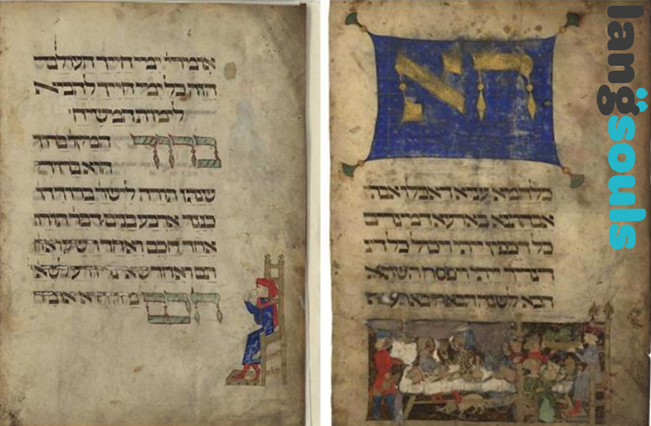This past Passover, I received a delightful surprise in the form of “300 Ways to Ask the Four Questions,” a charming book that unexpectedly enriched my understanding of Jewish culture. It led me to ponder the fascinating diversity of “Jewish” languages that exist, highlighting how language serves as a vital link to communication, expression, and the preservation of collective heritage.
The history of Jewish languages is a testament to the resilience and cultural wealth of the Jewish people. In this blog post, we embark on a captivating exploration of the origins, transformations, and enduring significance of Jewish languages, from ancient tongues to modern vernaculars.
Hebrew is the oldest known Jewish language, with origins dating back to biblical times. It was spoken by the ancient Israelites and served as the language of the Torah and other religious texts. Over the centuries, Hebrew evolved through different stages:
- Biblical Hebrew (approx. 10th century BCE – 4th century BCE): This ancient form of Hebrew is preserved in the Hebrew Bible (Tanakh) and other biblical writings.
- Mishnaic Hebrew (2nd century BCE – 2nd century CE): After the Babylonian exile, Hebrew developed into a new form known as Mishnaic Hebrew, which was used in the compilation of the Mishnah, a central text of Jewish law.
- Medieval Hebrew (6th century CE – 18th century CE): Hebrew continued to evolve during the medieval period, with the development of Hebrew poetry, philosophy, and liturgical texts.
- Modern Hebrew (late 19th century CE – present): The revival of Hebrew as a spoken language is credited to Eliezer Ben-Yehuda and the Zionist movement. Modern Hebrew is now the official language of the State of Israel and is spoken by millions worldwide.
Aramaic, another ancient Semitic language, that gained prominence during the Babylonian exile (6th century BCE) and became the lingua franca of the Jewish people in various regions. It played a significant role in Jewish literature and culture, particularly in the following periods:
- Biblical Aramaic: Portions of the biblical books of Daniel and Ezra are written in Aramaic, reflecting its usage during the Babylonian and Persian periods.
- Jewish Babylonian Aramaic (3rd century BCE – 11th century CE): This form of Aramaic developed in the Jewish community of Babylonia (present-day Iraq) and became the language of the Babylonian Talmud, a central text of Jewish law and commentary.
- Syriac (5th century CE – present): Aramaic continued to evolve into Syriac, a distinct dialect spoken by Syrian and Mesopotamian Jews and Christians. Syriac played a significant role in preserving and transmitting early Jewish and Christian writings.
Yiddish emerged as the vernacular language of Ashkenazi Jews in Central and Eastern Europe. It developed between the 9th and 12th centuries CE and reached its peak during the 18th and 19th centuries. However, the 20th century witnessed a tragic decline in Yiddish-speaking communities due to several factors:
- The Holocaust: The systematic persecution and murder of millions of Jews during World War II resulted in the decimation of Yiddish-speaking communities in Europe.
- Assimilation and Migration: After the war, many Yiddish-speaking Jews migrated to other countries, particularly to the United States and Israel. As subsequent generations assimilated into their new societies, the usage of Yiddish diminished.
- Revitalization Efforts: Despite these challenges, Yiddish continues to be preserved and celebrated by various cultural and educational institutions. Yiddish literature, theater, music, and academic programs contribute to the ongoing revitalization of the language.
Ladino, also known as Judeo-Spanish, developed among Sephardic Jews who were expelled from Spain during the Inquisition in the late 15th century. It evolved as a fusion of medieval Spanish, Hebrew, Arabic, and Turkish. The history of Ladino is marked by the following milestones:
Spanish Expulsion (1492): The expulsion of Jews from Spain resulted in the diaspora of Sephardic communities. Ladino became their primary language in the Ottoman Empire, North Africa, and other regions where they settled.
Decline and Revival: The Holocaust and subsequent emigration caused a decline in Ladino-speaking communities. However, efforts to preserve Ladino literature, music, and cultural heritage have sparked a revitalization movement in recent decades, ensuring its survival.
In addition to Hebrew, Aramaic, Yiddish, and Ladino, Jewish communities around the world have developed unique languages or dialects based on their geographic location and historical context:
- Judaeo-Arabic: This group of Arabic dialects infused with Hebrew elements was spoken by Arab Jews in the Middle East and North Africa.
- Judaeo-Persian: Spoken by Iranian Jews, Judaeo-Persian represents a Persian dialect influenced by Hebrew and Aramaic.
Regional Jewish Languages: Various Jewish communities in India, Ethiopia, and other regions developed their own languages or dialects, such as Judaeo-Malayalam and Ethiopian Jewish languages.
The history of Jewish languages is a complex tapestry reflecting the diverse experiences and journeys of Jewish communities across time and place. While Hebrew remains the sacred language and Modern Hebrew the official language of Israel, Aramaic, Yiddish, Ladino, and other Jewish languages bear witness to historical events, cultural interactions, and the resilience of Jewish identity. Despite challenges, efforts to preserve, revive, and celebrate these languages continue, ensuring that the linguistic heritage of the Jewish people remains alive and appreciated in the modern world.





